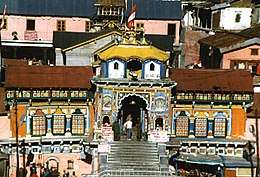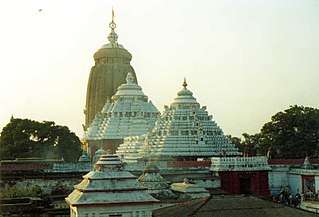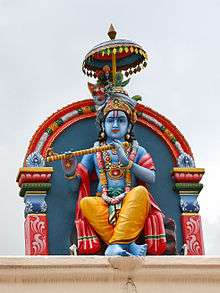Dwarkadhish Temple
| Dwarkadhish Temple | |
|---|---|
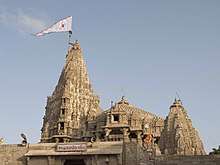 The temple sikhars with the entrance in front | |
 Location in Gujarat | |
| Geography | |
| Coordinates | 22°14′16.39″N 68°58′3.22″E / 22.2378861°N 68.9675611°ECoordinates: 22°14′16.39″N 68°58′3.22″E / 22.2378861°N 68.9675611°E |
| Country | India |
| State | Gujarat |
| Locale | Dwarka |
| Culture | |
| Sanctum | Dwarkadheesh Krishna |
| Major festivals | Janmastami |
| Char Dham
Dwarka • Puri |
|---|
The Dwarkadhish temple, also known as the Jagat Mandir and occasionally spelled Dwarakadheesh (Gujarati: દ્વારકાધીશ મન્દિર; Sanskrit and Hindi: द्वारकाधीश मन्दिर), is a Hindu temple dedicated to the god Krishna, who is worshiped here by the name Dwarkadhish, or 'King of Dwarka'. The temple is located at Dwarka, Gujarat, India. The main shrine of the 5-storied building, supported by 72 pillars, is known as Jagat Mandir or Nija Mandir, archaeological findings suggest it to be 2,200 - 2,000 years old.[1][2][3] Temple was enlarged in the 15th- 16th century.[4][5] The Dwarkadhish Temple is a Pushtimarg temple, hence it follows the guidelines and rituals created by Vallabhacharya and Vitheleshnath.
According to tradition, the original temple was believed to have been built by Krishna's grandson, Vajranabha, over the hari-griha (Lord Krishna's residential place). The temple became part of the Char Dham pilgrimage considered sacred by Hindus in India, after Adi Shankaracharya, the 8th century Hindu theologian and philosopher, visited the shrine. The other three being comprising Rameswaram, Badrinath and Puri. Even today a memorial within the temple is dedicated to his visit. Dwarakadheesh is the 98th Divya Desam of Vishnu on the subcontinent, glorified in the Divya Prabandha sacred texts.
Legend
As per Hindu legend, Dwarka was built on a piece of land by Krishna that was reclaimed from the sea. Sage Durvasa once visited Krishna and his wife Rukmini. The sage wished that the pair took him to their palace. The pair readily agreed and started walking with the sage to their palace. After some distance, Rukmini got tired and she requested some water from Krishna. Krishna dug a mythical hole that brought in river Ganga to the place. Sage Durvasa was furious and cursed Rukmini to remain in the place. The temple where Rukmini's shrine is found, is believed to the place where she stood.[6]
History
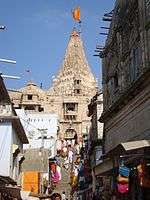
The town of Dwarka in Gujarat has a history that dates back centuries, and mentioned in the Mahabharat epic as the Dwaraka Kingdom. Situated on the banks of river Gomti, the town is described in legend as the capital of Lord Krishna. Evidence such as a stone block with script, the way the stones were dressed showing that dowels had been used, and an examination of anchors found on the site suggest that the harbour site dates only to historical times, with some of the underwater structure being late Medieval. Coastal erosion was probably the cause of the destruction of what was an ancient port.[7]
Hindus believe that the original temple was constructed by Vajranabh, the great grand son of Krishna, over the residential palace of Krishna.
The current temple in Chaulukya style is constructed in 15-16th century. The temple covers area of 27 metre by 21 metre with east-west length of 29 metre and north-south width of 23 metres. The tallest peak of the temple is 51.8 m high.
Religious importance
The flag atop the temple shows the sun and moon, which is believed to indicate that Krishna would be there till Sun and moon exist on earth.[8] The flag is changed from 5 times a day, but the symbol remains the same. The temple has a five-story structure built on seventy-two pillars. The temple spire is 78.3m high.[8][9] *The temple is constructed of limestone which is still in pristine condition. The temple shows intricate sculptural detailing done by successions of dynasties that ruled the region. The structure was not expanded much by these works. There are two entrances to the temple. The main entrance (north entrance) is called "Moksha Dwara" (Door to Salvation). This entrance takes one to the main market. The south entrance is called "Swarga Dwara" (Gate to Heaven). Outside this doorway are 56 steps that leads to the Gomati River.[10] The temple is open from 6.00 am to 1.00 pm and 5.00 pm to 9.30 pm. The Krishnajanmastami festival,or Gokulashtami, the birthday of Krishna was commissioned by Vallaba (1473-1531).[11]
References
- ↑ 1988. -Marine Archaeology of Indian Ocean Countries- S. R. Rao, page.18, text = "The Kharoshti inscription in the first floor of Sabhamandapa of Dwarkadhish Temple is assignable to 200 BC.", page.25 text = "Excavation was done by the veteran archaeologist H.D. Sankalia some twenty years ago on the western side of the present Jagat-Man- dir at Modern Dwarka and he declared that the present Dwarka was not earlier than about 200 BC."
- ↑ 2005, L. P. Vidyarthi -Journal of Social Research - Volume 17-, text= "Inscription in brahmi found in the temple supports the fact of its construction during the Mauryan regime. Apart from this beginning, the pages of history of Dwarka and Dwarkadhish temple are full of accounts of its destruction and reconstruction in the last 2000 years."
- ↑ 2005. -Remote Sensing And Archaeology- Alok Tripathi, page.79, text = In 1963 H.D. Sankalia carried out an archaeological excavation.. at Dwarkadheesh temple at Dwarka to solve the problem. Archaeological evidences found in this excavation were only 2000 years old
- ↑ 1988, P. N. Chopra, "Encyclopaedia of India, Volume 1", page.114
- ↑ Rao, Shikaripur Ranganath (1999). The lost city of Dvārakā. Aditya Prakashan. ISBN 978-8186471487.
- ↑ Bhoothalingam, Mathuram (2016). S., Manjula, ed. Temples of India Myths and Legends. New Delhi: Publications Division, Ministry of Information and Broadcasting, Government of India. pp. 87–91. ISBN 978-81-230-1661-0.
- ↑ Gaur, A.S.; Sundaresh and Sila Tripati (2004). "An ancient harbour at Dwarka: Study based on the recent underwater explorations". Current Science. 86 (9).
- 1 2 "Dwarkadish Temple, Dwarkadish Temple Dwarka, Dwarkadish Temple in India". Indianmirror.com. Retrieved 2014-03-04.
- ↑ "Gujarat- Volume 2 of Smt. Hiralaxmi Navanitbhai Shah Dhanya Gurjari Kendra Prakashan" - p. 445 - author = Hiralaxmi Navanitbhai
- ↑ Chakravarti 1994, p. 140
- ↑ Harshananda, Swami (2012). Hindu Pilgrim centres (2nd ed.). Bangalore, India: Ramakrishna Math. p. 87. ISBN 81-7907-053-0.
Notes
- UNESCO World Cultural Heritage Site status, report on Indian Express newspaper website
- Underwater remains near Dwarakadheesh temple, on website of National Institute of Oceanography
- Brockman, Norbert C. (2011). Encyclopedia of Sacred Places. California: ABC-CLIO, LLC. ISBN 978-1-59884-655-3.
- Gwynne, Paul (2009). World Religions in Practice: A Comparative Introduction. Oxford: Blackwell Publication. ISBN 978-1-4051-6702-4.
External links
| Wikimedia Commons has media related to Dwarakadheesh Temple. |
